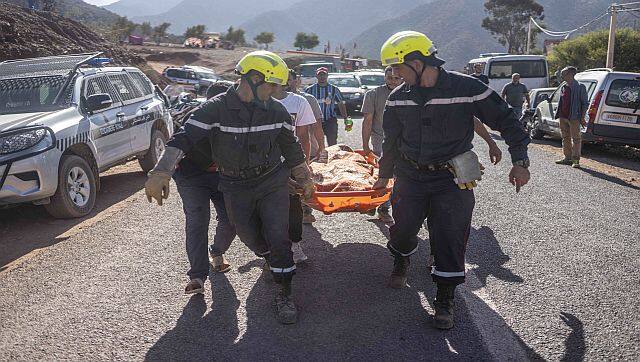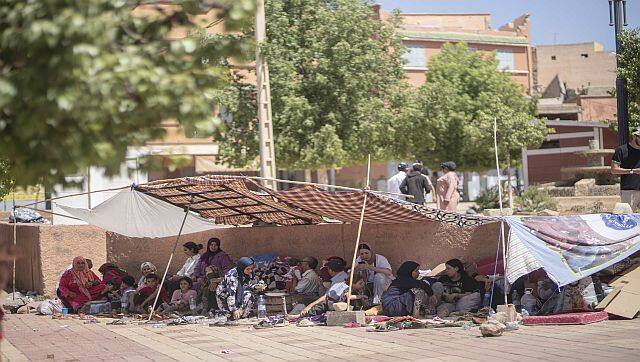Morocco has been devastated by an earthquake and needs help. Several countries, including Spain, the United Kingdom, and Qatar, have stepped in to assist the country in locating survivors from the rubble of mountain villages following the country’s strongest-ever earthquake. They are all racing against time. A Spanish military and rescue team of 56 officers and four dogs arrived Morocco on Sunday. Another team of 30 people and four dogs from Spain was also on its way to Morocco. The US sent a bteam, whereas the United Kingdom deployed 60 rescue specialists and four dogs. France has pledged two million euros (Rs 17.81 lakh) to Morocco, with Tunisia, Qatar, and Israel also supporting the rescue operation. Moroccans are mourning the victims of a terrible earthquake that claimed the lives of over 2,800 people and injured over 2,500 more. The United Nations estimates that 300,000 people were affected by the al-Houz earthquake, a severe 6.8 magnitude temblor that struck a region unused to and unprepared for such a jolt. In the disaster-stricken town of Talat Nyacoub, the army and police sent 12 ambulances and several dozen 4X4s, while over 100 Moroccan rescuers were searching for signs of life amid the collapsed buildings. Nearby, AFP saw a Spanish team of 30 firefighters, a doctor, nurse and two technicians coordinating with Moroccan authorities before starting to dig, as a helicopter flew overhead. “The big difficulty is in zones remote and difficult to access, like here, but the injured are choppered out,” Annika Coll, who heads the Spanish team, told AFP. About 70 kilometres (40 miles) north, another Spanish team from the Military Emergencies Unit (UME) had set up camp since Sunday night on the edge of Amizmiz village. ‘Completely lost’ AFP journalists in Amizmiz saw Moroccan troops handing out hundreds of blankets to residents who had lost their homes. “My mother died, her house is ruined. My place in Amizmiz no longer exists so we sleep outside in tents with my two children aged four months and six years,” said Hafid Ait Lahcen, 32, a construction worker. “No one from the authorities has offered us accommodation. We are completely lost.” [caption id=“attachment_13112302” align=“alignnone” width=“640”] Members of rescue teams carry the body of a victim of an earthquake in Ouargane village, near Marrakech, Morocco. AP[/caption] Albert Vasquez, the Spanish unit’s communications officer, said his team was awaiting a meeting with Moroccan civil defence to determine exactly where they were needed. Time was short, and Vasquez warned that “it’s very difficult to find people alive after three days” but “hope is still there”. The rescuers are assisted by four dogs and micro cameras that can be fed into the rubble in an effort to detect signs of life. For Lahcen and Habiba Barouj, the help came too late. An ambulance took their father, 81, to hospital with a broken leg.
Also Read: Why the Morocco earthquake was so devastating
The previous evening, they buried their mother who was killed in the quake. “We didn’t see any rescuers. We had to get our father out from the rubble ourselves,” said Habiba Barouj, her face drawn. “Our house has been swallowed up.” ‘The village is dead’ Rabat on Sunday announced it had accepted offers to send search and rescue teams from Britain, Qatar and the United Arab Emirates, as well as Spain. “The UK is deploying a team of search and rescue specialists, including 60 people, four search dogs and rescue equipment, as well as a medical assessment team,” the British Foreign, Commonwealth & Development Office said in a statement late Sunday. The earthquake wiped out entire villages in the foothills of the Atlas Mountains, where civilian rescuers and members of Morocco’s armed forces have searched for survivors and the bodies of the dead. [caption id=“attachment_13112282” align=“alignnone” width=“640”]
Members of rescue teams carry the body of a victim of an earthquake in Ouargane village, near Marrakech, Morocco. AP[/caption] Albert Vasquez, the Spanish unit’s communications officer, said his team was awaiting a meeting with Moroccan civil defence to determine exactly where they were needed. Time was short, and Vasquez warned that “it’s very difficult to find people alive after three days” but “hope is still there”. The rescuers are assisted by four dogs and micro cameras that can be fed into the rubble in an effort to detect signs of life. For Lahcen and Habiba Barouj, the help came too late. An ambulance took their father, 81, to hospital with a broken leg.
Also Read: Why the Morocco earthquake was so devastating
The previous evening, they buried their mother who was killed in the quake. “We didn’t see any rescuers. We had to get our father out from the rubble ourselves,” said Habiba Barouj, her face drawn. “Our house has been swallowed up.” ‘The village is dead’ Rabat on Sunday announced it had accepted offers to send search and rescue teams from Britain, Qatar and the United Arab Emirates, as well as Spain. “The UK is deploying a team of search and rescue specialists, including 60 people, four search dogs and rescue equipment, as well as a medical assessment team,” the British Foreign, Commonwealth & Development Office said in a statement late Sunday. The earthquake wiped out entire villages in the foothills of the Atlas Mountains, where civilian rescuers and members of Morocco’s armed forces have searched for survivors and the bodies of the dead. [caption id=“attachment_13112282” align=“alignnone” width=“640”] People shelter in tents after their homes were damaged by the earthquake, in the town of Amizmiz, near Marrakech, Morocco. AP[/caption] Many houses in remote mountain villages were built from mud bricks. While the foreign teams begin to arrive, Moroccan authorities have erected emergency shelters. Bright yellow tents were visible along the road into Tikht, a village which has effectively ceased to exist. Members of the government’s civil protection service carried camp beds from a military-type truck toward the tents. Previously home to at least 100 families, Tikht has been reduced to a tangle of timber, chunks of masonry as well as broken plates, shoes and the occasional intricately patterned rug. “Life is finished here,” said Mohssin Aksum, 33, who had family in the settlement. “The village is dead.” Blood donations Citizens reported to hospitals in Marrakesh and elsewhere to donate blood for the injured. Among the donors were members of Morocco’s national football team and renowned French-Moroccan comic Jamel Debbouze. Other volunteers organised food and essential goods to help quake victims, after complaints that authorities were slow to respond.
Also Read: Morocco earthquake: Why tourists are not cancelling their travel plans
“Everyone must mobilise,” said one volunteer, Mohamed Belkaid, 65. “And that includes the authorities, but they seem to be absent.” Yacine Benhania, another volunteer, complained of a “shortage of medicines, particularly for diabetes and hypertension”. The education ministry announced that school classes were “suspended” in the worst-hit villages of Al-Haouz province, the quake epicentre. Some parts of Marrakesh’s historic medina and its network of alleyways saw significant damage, with mounds of rubble and crumpled buildings in the World Heritage site. Dozens of people continued to sleep outdoors overnight in the modern quarter of Marrakesh. The UN Human Rights Council in Geneva began its session on Monday with a minute’s silence for the quake victims. “We are part of a global collectivity: humanity,” said Gambia’s ambassador Muhammadu Kah, who proposed the tribute. The quake was the deadliest in Morocco since a 1960 earthquake destroyed Agadir, killing 12,000-15,000 people. With inputs from AFP
People shelter in tents after their homes were damaged by the earthquake, in the town of Amizmiz, near Marrakech, Morocco. AP[/caption] Many houses in remote mountain villages were built from mud bricks. While the foreign teams begin to arrive, Moroccan authorities have erected emergency shelters. Bright yellow tents were visible along the road into Tikht, a village which has effectively ceased to exist. Members of the government’s civil protection service carried camp beds from a military-type truck toward the tents. Previously home to at least 100 families, Tikht has been reduced to a tangle of timber, chunks of masonry as well as broken plates, shoes and the occasional intricately patterned rug. “Life is finished here,” said Mohssin Aksum, 33, who had family in the settlement. “The village is dead.” Blood donations Citizens reported to hospitals in Marrakesh and elsewhere to donate blood for the injured. Among the donors were members of Morocco’s national football team and renowned French-Moroccan comic Jamel Debbouze. Other volunteers organised food and essential goods to help quake victims, after complaints that authorities were slow to respond.
Also Read: Morocco earthquake: Why tourists are not cancelling their travel plans
“Everyone must mobilise,” said one volunteer, Mohamed Belkaid, 65. “And that includes the authorities, but they seem to be absent.” Yacine Benhania, another volunteer, complained of a “shortage of medicines, particularly for diabetes and hypertension”. The education ministry announced that school classes were “suspended” in the worst-hit villages of Al-Haouz province, the quake epicentre. Some parts of Marrakesh’s historic medina and its network of alleyways saw significant damage, with mounds of rubble and crumpled buildings in the World Heritage site. Dozens of people continued to sleep outdoors overnight in the modern quarter of Marrakesh. The UN Human Rights Council in Geneva began its session on Monday with a minute’s silence for the quake victims. “We are part of a global collectivity: humanity,” said Gambia’s ambassador Muhammadu Kah, who proposed the tribute. The quake was the deadliest in Morocco since a 1960 earthquake destroyed Agadir, killing 12,000-15,000 people. With inputs from AFP
From rescue teams to blood donations: How countries are aiding quake-hit Morocco
FP Explainers
• September 12, 2023, 08:54:15 IST
Moroccan rescuers supported by foreign teams face an intensifying race against time to dig out any survivors from the rubble of mountain villages after the country’s strongest-ever earthquake. The temblor has killed at least 2,800 people and injured over 2,500 others, so far
Advertisement
)
End of Article